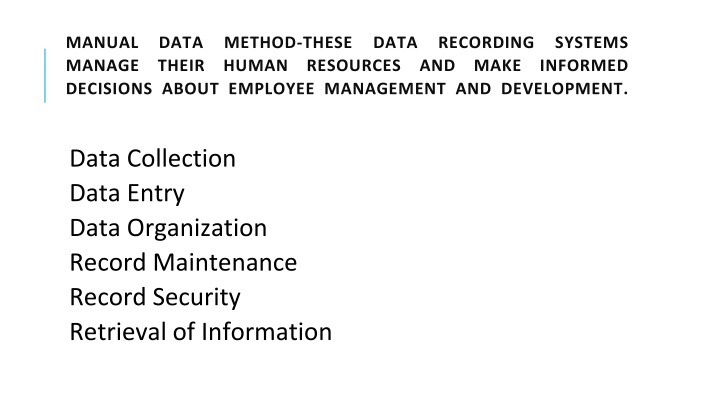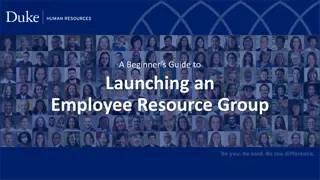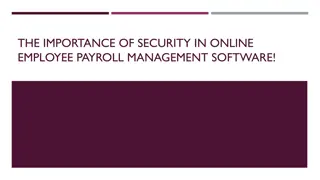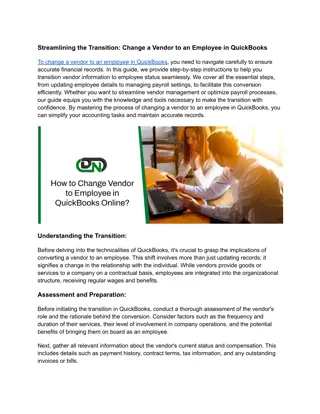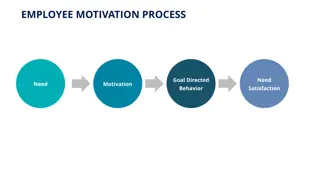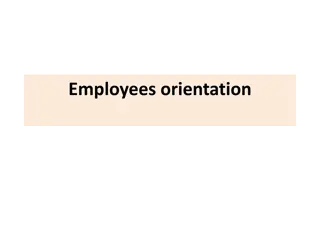Employee Data Management Guide
HR personnel collect various types of employee data such as personal information, employment history, performance evaluations, training records, and disciplinary actions. This data is manually entered, organized, maintained, secured, and retrieved to facilitate effective decision-making in employee management and development.
Download Presentation

Please find below an Image/Link to download the presentation.
The content on the website is provided AS IS for your information and personal use only. It may not be sold, licensed, or shared on other websites without obtaining consent from the author.If you encounter any issues during the download, it is possible that the publisher has removed the file from their server.
You are allowed to download the files provided on this website for personal or commercial use, subject to the condition that they are used lawfully. All files are the property of their respective owners.
The content on the website is provided AS IS for your information and personal use only. It may not be sold, licensed, or shared on other websites without obtaining consent from the author.
E N D
Presentation Transcript
MANUAL MANAGE DECISIONS ABOUT EMPLOYEE MANAGEMENT AND DEVELOPMENT. DATA THEIR METHOD-THESE HUMAN DATA RECORDING AND MAKE SYSTEMS INFORMED RESOURCES Data Collection Data Entry Data Organization Record Maintenance Record Security Retrieval of Information
DATA COLLECTION Data Collection: HR personnel collect various types of employee data such as personal information, employment history, performance evaluations, training records, and disciplinary actions.
DATA ENTRY Data Entry: The collected data is then manually entered into physical registers or files. This can involve writing down information by hand or typing it into predefined forms or documents.
DATA ORGANIZATION: Data Organization: Once the data is entered, it needs to be organized systematically. This may involve arranging files alphabetically, numerically, or categorically for easy retrieval and reference.
RECORD MAINTENANCE Record Maintenance: HR staff must ensure the accuracy and completeness of the recorded data. Regular maintenance is required to update the information as needed and to remove outdated records.
RECORD SECURITY Record Security: It's essential to maintain the security and confidentiality records. of the physical These files must be stored in locked cabinets or secure rooms to prevent unauthorized access or potential data breaches.
RETRIEVAL OF INFORMATION Retrieval of Information: necessary, HR professionals need retrieve specific employee data from the physical records. When to This may involve manually searching through files to locate information. the required
ADVANTAGES OF MANUAL DATA RECORDING Cost-effective: Setting up a manual record-keeping system may require minimal investment in physical registers and file storage. Easy physical records may be easier to understand and navigate compared to digital systems. to understand: For some employees,
ADVANTAGES OF MANUAL DATA RECORDING Reliability: Physical records are not subject to electronic malfunctions or cyber-attacks, thus providing a reliable form of data storage. Limited accessibility: Physical records may not be easily accessible to authorized personnel at all times, especially if they are located in a central file room.
DISADVANTAGES OF MANUAL DATA RECORDING: Time-consuming: retrieving data takes more time compared to digital systems. Error-prone: Human error in data entry and maintenance can lead to inaccuracies and discrepancies in the records. Manually recording and
DISADVANTAGES OF MANUAL DATA RECORDING: Limited accessibility: Physical records may not be easily accessible personnel at all times, especially if they are located in a central file room. to authorized
CONCLUSION Overall, while manual data recording in physical registers and files may be suitable for small organizations with limited resources. it is gradually being replaced by more efficient and secure digital HR management systems.
